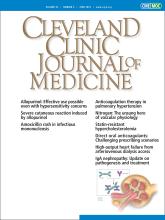A previously healthy 23-year-old woman was referred to our medical center with a 2-day history of a generalized pruritic rash. Seventeen days before presentation, she noticed bilateral swelling in her neck, and 3 days later she developed a fever (39.0°C [102.2°F]) and sore throat. Subsequently, she visited a local clinic where she had a rapid antigen-detection test, which was positive for group A Streptococcus, and she was prescribed a 10-day course of amoxicillin. Her fever and sore throat improved, but the neck swelling persisted. The rash that prompted her current visit developed on the day she completed amoxicillin therapy.
The patient had no history of allergic reactions, and it was unclear whether she had previously been exposed to beta-lactam antibiotics. Because of her work as a part-time piano teacher, she had regular contact with children.
Physical examination showed bilateral tonsillar enlargement; bilateral posterior cervical lymphadenopathy with tenderness; and maculopapular exanthem on the face, trunk, and limbs, including the palms and soles (Figure 1). Laboratory tests revealed an elevated white blood cell count of 10.7 × 109/L (reference range 3.3–8.6) and 11.5% atypical lymphocytes. Eosinophil count, alkaline phosphatase, aspartate aminotransferase, and alanine aminotransferase were within normal limits. Additional tests showed elevated immunoglobulin (Ig) M and IgG antibodies to Epstein-Barr virus capsid antigen and were negative for IgG antibody to Epstein-Barr virus nuclear antigen, cytomegalovirus antibody, and human immunodeficiency virus antigen and antibody tests.
Faint generalized erythematous papules and macules with mild pruritus on the patient’s (A) right shoulder and (B) hands, including the palms.
Amoxicillin rash against a background of infectious mononucleosis was diagnosed. All symptoms resolved by the outpatient follow-up visit 10 days after initial presentation, and the patient was lost to follow-up.
RASH AFTER AMOXICILLIN USE IN INFECTIOUS MONONUCLEOSIS
Amoxicillin rash often occurs after a patient with infectious mononucleosis is given an antimicrobial agent. The rash—a diffuse pruritic maculopapular exanthem that often involves the palms and soles—typically appears 7 to 10 days after antimicrobial administration and resolves within a week.1,2 The differential diagnosis of skin lesions in patients with infectious mononucleosis includes Gianotti-Crosti syndrome (also known as infantile papular acrodermatitis, it is characterized by an erythematous papular rash on the face and limbs that clears in several weeks), Stevens-Johnson syndrome, and viral infections such as varicella-zoster virus and enterovirus3; not all these entities have this appearance.
Group A streptococcal infection can co-occur with infectious mononucleosis. Because antimicrobial therapy is warranted to treat the bacterial infection, patients with coinfection are at risk of amoxicillin rash.4 For example, a study of 222 children with acute group A streptococcal pharyngitis found that up to 18% had an Epstein-Barr virus coinfection.5 However, distinguishing between a true coinfection and group A streptococcal colonization is challenging.4 Therefore, administering antibiotics to treat confirmed symptomatic group A streptococcal pharyngitis is still reasonable to prevent rheumatic fever and complications and reduce infection, even if there is a possible Epstein-Barr virus coinfection.
Amoxicillin rash incidence in patients with infectious mononucleosis traditionally has been thought to be as high as 95%,1,4 but recent studies suggest that it may be much lower, ranging from 15% to 33%.2,6,7 This discrepancy may be attributed to possible contamination of the antibiotics used in an earlier era or to differences in age, ethnicity, and genetics in study participants.2 Although rash frequency is high among patients with infectious mononucleosis after administration of amoxicillin or ampicillin, a recent study found that the frequency of rash with these antibiotic agents is similar to that of other antibiotics.8 Thus, prescribing alternative non–beta-lactam antibiotics for group A streptococcal pharyngitis may not necessarily lower the risk of rash.
Drug allergy, intolerance, or hypersensitivity
The most plausible cause of amoxicillin rash in infectious mononucleosis is a transient virus-mediated immune change that decreases antigenic tolerance and leads to a delayed-type hypersensitivity reaction to the antibiotic.2 This transient immunostimulation is distinct from a beta-lactam allergy. An amoxicillin rash occurring in the setting of infectious mononucleosis may not indicate a true penicillin allergy, although reliable data are scarce regarding the frequency of rash recurrence after readministration of a beta-lactam antibiotic in patients with a diagnosis of infectious mononucleosis and history of amoxicillin rash.2
However, it is possible that a true and persistent drug hypersensitivity can arise during the course of infectious mononucleosis. In one study, 5 of 8 patients with infectious mononucleosis who developed a rash after aminopenicillin use had positive amoxicillin patch tests more than 3 months after infectious mononucleosis was completely resolved.2,9 It is crucial to note that the study did not differentiate between preexisting or inherent drug allergies and true hypersensitivity reactions newly induced by Epstein-Barr virus infection. To date, no high-quality studies have rigorously distinguished between these 2 reaction types and accurately estimated the risk of persistent drug hypersensitivity after an Epstein-Barr virus infection.
While clinicians should avoid diagnosing penicillin allergy in patients with an amoxicillin rash during an infectious mononucleosis episode, patients should be involved in the decision to conduct allergy testing to differentiate between a transient immunostimulation-related amoxicillin rash and a true beta-lactam allergy. Clinicians should also be vigilant and carefully assess a rash that occurs in patients with acute pharyngitis, considering the possibility of Epstein-Barr virus infection.
DISCLOSURES
The author reports no relevant financial relationships which, in the context of their contributions, could be perceived as a potential conflict of interest.
- Copyright © 2025 The Cleveland Clinic Foundation. All Rights Reserved.







